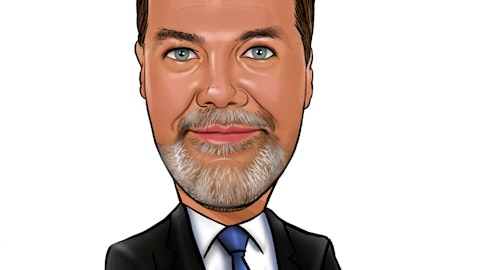Mike Fowler: Right. So thank you, appreciate the question. So our margin in December at compressed to about 335. We did see deposit pricing pressure pick up late in the quarter. And we saw the beta related to Fed moves pickup in the quarter. We are hopeful that some of that is competing with banks that are sort of getting ahead of the Fed’s next move from a pricing standpoint. But we clearly saw deposit pricing pressure on an exception basis. And if promotion basis pick up late in the quarter. And one thing I would say in terms of margin as Tim said, we’ve always targeted on the loan side is spread over home loan match-funded, the home loan. When rates were at historic lows it was very difficult to get much spread on the deposit side, even with deposit pricing, getting more aggressive we are getting more spread on the deposit side to contribute to the margin than we did when rates were at historic lows.
Even the wholesale rates, we’ve been tapping which have been brokered not home loan, add to a year they’ve ranged 30, 40, 50 basis points below match funded wholesale home loan and our deposit pricing, we are trying to be flexible in terms of responding to competitor offers and competitor exception rates to retain profitable customers and to potentially attract broad relationships we will never go really to or above our wholesale alternatives. So even if more aggressive deposit pricing, we are still getting reasonably attractive spreads on the deposit side, the less so than a little bit earlier in the year.
Brett Rabatin: Okay. That’s helpful. And then wanted to just turn to the SBA business and wanted to make sure I understood the pace of the improvement to the $2 million quarterly number, what that might look like and then I’ve heard some banks say that they are less optimistic on SBA, in the current environment. And so I just wanted to make sure I understood the decision to the bulk of it and just what the expectations might be from a credit perspective.
Chris Tietz: Sure, Brett, this is Chris. A couple of things that I’d note. If you compare SBA over time, this is a period like every other fee business where margins have been under pressure, okay? Alone that guaranteed portion that you could sell for 10% to 12% are premium, say a year or two years ago might go for something around 8% premium or less. And I suspect that impacts the expectations of some of these lenders out there in the space and so on. So as to the trajectory for growth, I think it will be fairly rapid. I am optimistic that we will be at that run-rate that I mentioned of about $2 million by the end of the year, but I think that we need another quarter or two to settle in at current levels before we push the envelope on that.
Tim Schools: And Brett, I might add that, I mean, we understand we’re running a public company and there’s different mandates from different investors and we want to build a great company and we want to build an institution to last, and so this is one of those that as we continue to improve our performance this actually came to us, we didn’t go seeking for it. And so you have to evaluate it as an investment and I would say we don’t want to do anything that’s not profitable or accretive to our value, but look at we don’t pretend to think will be Live Oak, but look at the great institution, they’ve built with this product over time. So spreads and different things will come and go. These are people that we referenced and checked and very great reputations, they’ve done it a long time from top 10 SBA units and so we’re going to — we want to go fast, and we want to go slow, right?



